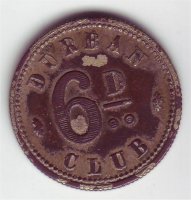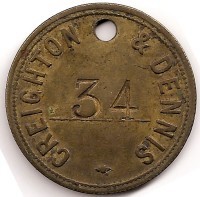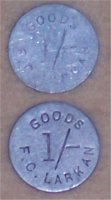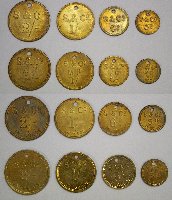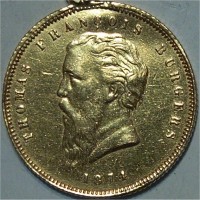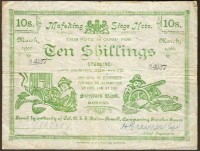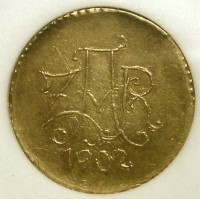| All the pieces displayed below are "chariots". |
Number known | Description | Value (US$) |
| Unique | 1860 Durban Club 6d pattern
This unique Durban Club six pence pattern was struck before the coins were issued in 1860. There are three known varieties according to Dr Theron, Pat Moran, E J Maynard, Hern and others. These varieties include: a 6d with a milled edge, a plain edge and a white metal piece. The Balson Holdings Family Trust owns two sets of the three varieties and this unique pattern.
|
3,500 | |
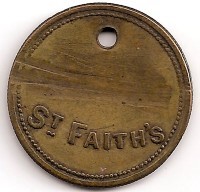 |
Unique | St Faiths 6d
Not much is known about this token but there is a Roman Catholic Mission (if you dare cross a real scary and old timber bridge over a deep gorge) in the St Faith's, Umtentweni, district east of Ixopo. This coin is the only one of its type on record. |
3,000 |
| Unique | Creighton and Dennis 1/-
There is a small community at Creighton not far from Ixopo but no-one could help me regarding the history of a company called "Creighton and Dennis" except for the comment that there was a store called Creighton and Dennis at the turn of the century (1900) and that the tokens were used by labour at the store to be redeemed in goods at the store. |
2,500 | |
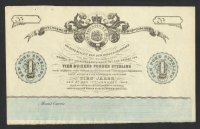 |
Circa 20 | Griqua Een Pond bank note
This extremely rare Griqua bank note (Government of New Griqualand - Gouvernement van Nieuw Griqualand) was never issued. Copies of the original note can only be found in the Rev William Dower's book "The Early Annals of Kokstad and East Griqualand" (published 1902). The Balson Holdings Family Trust owns three (3) copies of Dower's original book and several 1978 reprints by the Killie Campbell Library (Durban, Natal, South Africa) which are used for hands-on research purposes. There are only a handful of the original book and note, seen left, in existence, most are in museums like the Killie Campbell Library (University of Natal). The books in the Balson Holdings Family Trust collection have been secured after twenty five years of intensive search. On page 129 of the book Rev W Dower thanks "D Strachan Esq for the blank paper money...." |
10,000 ea |
| Several unique engraved pieces
Uncorroded pieces Circa 20 for each value |
1907 F C Larkan trade tokens
The minting of Frances Charlotte Larkan's tokens in 1907 was of four
denominations: According to Percy Larkan about 2,000 tokens were minted (about one third mainly corroded pieces remain). The natives were quick to give them the name "amakence" (after the Strachan and Co "kence"). The aluminium tokens are uniface bearing the details "Goods" and "F C Larkan" in the surround with the value in the center. Five type sets are known to have been modified from the original machine engraved tokens. Each type is represented by a symbol hand engraved with a sharp instrument into the blank back of the tokens. According to Percy Larkan the blank token with no engraving on the back, the commonest, originated from the Bont Rand store. |
From 50 to 1,000 each |
|
| Circa 30 | 1890 Griquatown Penny
The most plausible story behind the minting of the Griquatown penny is recorded in the covering preamble by Spink and Sons South African agent, City Coins of Cape Town, Dr Frank Mitchell, a Fellow of the South African Numismatic Society, when the coin below, came up for auction in 1985. Mitchell claims that: "The patterns were struck in Germany between 1874 and 1890 in an endeavour to solicit orders from the Transvaal Republic (the ZAR); the Orange Free State and the Cape..." (See Frank Mitchell's correspondence to Scott Balson at this link). |
1200 | |
| Circa 40 | 1864 Durban Bank £5 note
These extremely rare notes were issued between 1862 and 1877 by the Durban Bank (Hartley and Company) in Durban, Natal. |
1500 | |
Circa 100 sets of 16 tokens |
1874 - 1932 Strachan and Co trade tokens
The most sought after and best researched South African trade token. There are only 60 sets in the world. The first two sets (those without the words "In Goods") circulated from 1874 to 1932 and were South Africa's first widely accepted indigenous currency. The rare Mountain Home (MH) sets numbers about 100 pieces each. |
Over 3,000 per set | |
| 142 | 1874 coarse beard Burgerspond
L C Wyon from the Royal Mint cut the dies from the portrait and the sketch. The coins were struck by Ralph Heaton and Sons of Birmingham. The first shipment of 695 Burgersponde was despatched to the Republic in early August 1874 - these are known as the fine beard variety. The die broke - and a smaller second batch, the rarer coarse beard variety (seen left), numbering just 142 pieces was minted - Pratt keeping four of these coins for himself before they were shipped in October 1874. |
5,000 | |
| Circa 200 | 1900 - Mafeking Siege Bank Note
This ten-shilling note was printed from a woodcut, using a croquet mallet cut in half for the block. As each issue of notes was released into circulation, the army paymaster gave the notes authority by depositing a cheque of an equivalent amount into the Mafeking branch of the Standard Bank of South Africa. The issue could thus be redeemed at that bank following the resumption of civil law. Robert Bradshaw Clarke Urry, the then manager of the Standard Bank at Mafeking in South Africa, co-signed the siege notes with the "Army Pay master", Captain Greener. Over £5,228 in notes and coupons were issued, however, little more than £638 were ever redeemed. The rest were kept as souvenirs of the siege, and redemption of the notes ceased in September 1908. |
250 |
